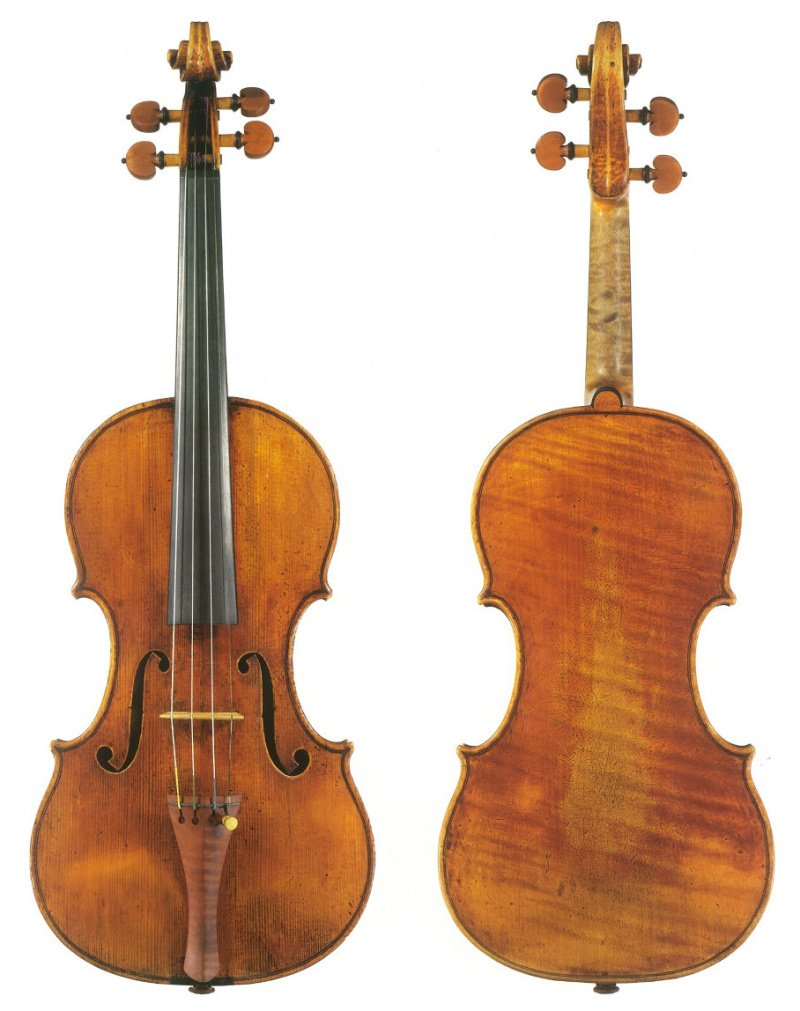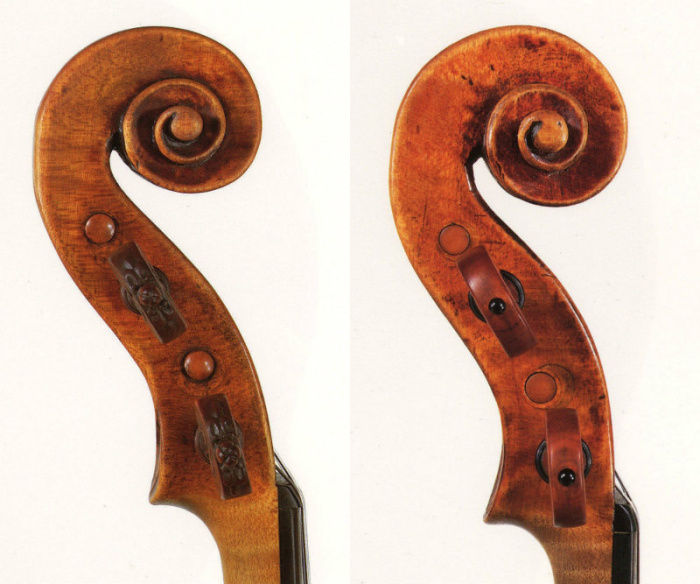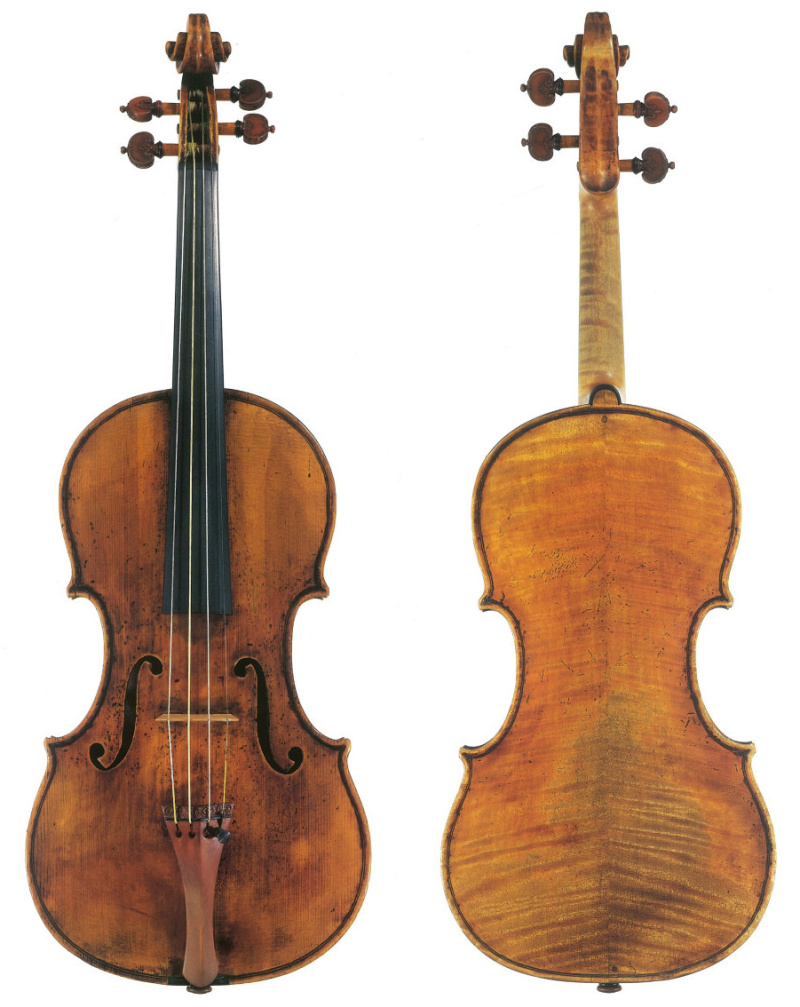In Part 1 we saw how the young Giuseppe Guarneri’s hand can be identified in the later instruments of his father, Giuseppe ‘filius Andreae’. The key influence seen in middle-period ‘del Gesù’ instruments, however, is not that of his father but his aging contemporary in Cremona, Antonio Stradivari.
Although ‘filius Andreae’ was not unaware of Stradivari’s innovative ideas, his roots were deep in the Amati tradition of relatively high, recurved archings and short, elegant soundholes with narrow wings. As Count Cozio observed, the first distinctive ‘del Gesù’ violins are clearly modeled on Stradivari, with low, flat, powerful archings and distinctive, broad soundholes with wider wings. The general outline remained faithful to the Amati form, however, and though the execution became freer (a lot freer in later life), this model, handed down through three generations of the Guarneri family, remained the basis for all his subsequent work. It is extraordinary to realise that all the varied models and styles created by ‘del Gesù’ probably originated from one single mould, freely used, and exploiting the remarkable flexibility of the Cremonese internal form to the ultimate degree.

The ‘Plowden’ ‘del Gesù’ is one of the finest middle-period examples and is characteristically small in size. Photos: Peter Biddulph Ltd
![]()
What is particularly interesting about the early violins, up to 1733, is the form of the scroll. ‘Del Gesù’ worked to a quite original design: surprisingly elegant, narrow across the front face and first turn, with delicate chamfers and detailing. These scrolls represent a strong departure from the forms used by Andrea, the Pietros of Venice and Mantua, and Giuseppe ‘filius Andreae’, which are very consistent with each other and not always readily distinguishable. The c. 1731 ‘Baltic’ (ID 40410), which has the earliest known ‘IHS’ label, has a fine example of this type of scroll, showing the distinctive handiwork of ‘del Gesù’ .
This changed in about 1733, the time when his father seems to have become incapacitated. For several years, up until about 1737, the elder Giuseppe seems to have supplied scrolls for his son, possibly because he was too ill to carry out larger-scale work. The scrolls of this middle period revert to the familiar Guarneri type, somewhat heavy in the working, with a broad second turn and distinctive ‘comma tail’ to the eye. This change caused confusion among some 19th-century experts, who assumed that these instruments were entirely the late work of ‘filius Andreae’.

The c.1731 ‘Baltic’ (left) shows the elegant scroll design introduced by ‘del Gesù’, while the 1735 ‘Plowden’ head (right) was probably made by ‘filius Andreae’ for his son and reverts to the old, slightly heavier Guarneri style
The middle period contains some of ‘del Gesù’s most conventionally attractive work. These are lovely imitations of Stradivari, showing a light, unselfconscious touch, but a fully developed tonal direction, with strong thicknesses of wood, low, stiff archings and quite large, open cut soundholes. ‘Del Gesù’ also stayed faithful to the principles of Amati construction, with the various pins, markings-out and internal structure used by them, and therefore almost certainly the exact same technical method.
This stands apart from Stradivari himself, who seems to have worked in a unique way, arriving at a quite different form and style. Both ‘del Gesù’ and Stradivari were highly creative makers, bursting out of the restrictive systems of the old Cremonese school, but manifesting this creativity in different ways. The ‘Plowden’ ‘del Gesù’ of 1735 (ID 40418) is one of the finest examples from this period; it is characteristically quite small in size, achieved by reducing the overhang of the edges, and made with the most beautiful wood. In fact ‘del Gesù’ wood is far more consistently well-figured than that of Stradivari, who frequently used quite plain pieces and cheaper, native species. It seems to refute the idea that he was working in poverty or desperation.

The 1740 ‘Heifetz’ contrasts remarkably with the ‘Plowden’ of 1735 and heralds the start of the extraordinarily experimental late period. Photos: Peter Biddulph Ltd
![]()
Stradivari’s death in 1737 was a momentous event in Cremona. His influence on the craft of making in Cremona was more than just as the best and most skilful, and of course the most long-lived of his peers. His presence was felt by all the luthiers of the city – the Guarneri, Rugeri and Bergonzi families and his own sons – in keeping a discipline and some sort of control over everything that was made there. After his death, things quickly spiralled off in different directions. ‘Del Gesù’ certainly seems to have been liberated from the rigid formalities of violin making. The differences between the ‘Plowden’ of 1735 and the ‘Heifetz’ of c. 1740 (ID 40097) are remarkable. From 1741 ‘del Gesù’ seemed almost determined to make a radically different instrument every time. Although one can certainly see pairs, such as the ‘Alard’ (ID 40444) and ‘Lord Wilton’ (ID 40256) of 1742 , and the ‘Cannone’ (ID 40130) and ‘Carrodus’ (ID 40447) of 1743, experimentation and self-expression seem to be his guiding principles.
This is what makes ‘del Gesù’ stand apart as the alternative genius of Cremona, the ying to Stradivari’s yang. Up until this point Cremonese violin making had been about consistency, not just of a very high level of craftsmanship, but of style and model. The differences between an Andrea Amati made in 1566 and a Nicolò Amati made in 1686, or even a Strad made in 1726, are technically significant, but small considering the time span. ‘Del Gesù’ was a true revolutionary, but there is a strong sense that he could only begin this radical work once Stradivari had departed the stage…
In Part 3, we look at the revolutionary genius that inspired the late instruments of ‘del Gesù’.
John Dilworth and Carlo Chiesa are among the world’s foremost makers, experts and restorers of fine violins. They helped co-write ‘Giuseppe Guarneri del Gesu’ alongside other books.